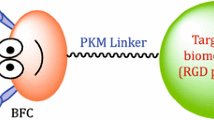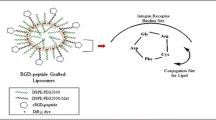Abstract
Purpose
Cell adhesion molecule integrin αvβ3 is an excellent target for tumor interventions because of its unique expression on the surface of several types of solid tumor cells and on almost all sprouting tumor vasculatures. Here, we describe the development of near-infrared (NIR) fluorochrome Cy7-labeled RGD peptides for tumor integrin targeting.
Procedures
Mono-, di-, and tetrameric RGD peptides were synthesized and conjugated with Cy7. The integrin specificity of these fluorescent probes was tested in vitro for receptor binding assay and fluorescence microscopy and in vivo for subcutaneous U87MG tumor targeting.
Results
The tetrameric RGD peptide probe with the highest integrin affinity showed the highest tumor activity accumulation and strongest tumor-to-normal tissue contrast. This uptake is integrin-specific as the signal accumulated in the tumor can be effectively blocked by unconjugated RGD peptide antagonist of integrin αvβ3.
Conclusions
Noninvasive NIR fluorescence imaging is able to detect and semiquantify tumor integrin expression based upon the highly potent tetrameric RGD peptide probe.







Similar content being viewed by others
References
Ruoslahti E (1996) RGD and other recognition sequences for integrins. Annu Rev Cell Dev Biol 12:697–715
Xiong JP, Stehle T, Zhang R, et al. (2002) Crystal structure of the extracellular segment of integrin αvβ3 in complex with an Arg–Gly–Asp ligand. Science 296:151–155
Brooks PC, Clark RA, Cheresh DA (1994) Requirement of vascular integrin αvβ3 for angiogenesis. Science 264:569–571
Kumar CC (2003) Integrin αvβ3 as a therapeutic target for blocking tumor-induced angiogenesis. Curr Drug Targets 4:123–131
Hood JD, Cheresh DA (2002) Role of integrins in cell invasion and migration. Nat Rev Cancer 2:91–100
Egeblad M, Werb Z (2002) New functions for the matrix metalloproteinases in cancer progression. Nat Rev Cancer 2:161–174
Jin H, Varner J (2004) Integrins: Roles in cancer development and as treatment targets. Br J Cancer 90:561–565
Brooks PC, Stromblad S, Sanders LC, et al. (1996) Localization of matrix metalloproteinase MMP-2 to the surface of invasive cells by interaction with integrin αvβ3. Cell 85:683–693
Schmieder AH, Winter PM, Caruthers SD, et al. (2005) Molecular MR imaging of melanoma angiogenesis with αvβ3-targeted paramagnetic nanoparticles. Magn Reson Med 53:621–627
Chen X, Park R, Hou Y, et al. (2004) MicroPET imaging of brain tumor angiogenesis with 18F-labeled PEGylated RGD peptide. Eur J Nucl Med Mol Imaging 31:1081–1089
Beck V, Herold H, Benge A, et al. (2005) ADAM15 decreases integrin αvβ3/vitronectin-mediated ovarian cancer cell adhesion and motility in an RGD-dependent fashion. Int J Biochem Cell Biol 37:590–603
Chen X, Park R, Tohme M, et al. (2004) MicroPET and autoradiographic imaging of breast cancer alpha v-integrin expression using 18F- and 64Cu-labeled RGD peptide. Bioconjug Chem 15:41–49
Chen X, Liu S, Hou Y, et al. (2004) MicroPET imaging of breast cancer alphav-integrin expression with 64Cu-labeled dimeric RGD peptides. Mol Imaging Biol 6:350–359
Meerovitch K, Bergeron F, Leblond L, et al. (2003) A novel RGD antagonist that targets both αvβ3 and α5β1 induces apoptosis of angiogenic endothelial cells on type I collagen. Vascul Pharmacol 40:77–89
Qiao RL, Yan W, Lum H, et al. (1995) Arg–Gly–Asp peptide increases endothelial hydraulic conductivity: Comparison with thrombin response. Am J Physiol 269:C110–C117
Haubner R, Wester HJ (2004) Radiolabeled tracers for imaging of tumor angiogenesis and evaluation of anti-angiogenic therapies. Curr Pharm Des 10:1439–1455
Leong-Poi H, Christiansen J, Klibanov AL, et al. (2003) Noninvasive assessment of angiogenesis by ultrasound and microbubbles targeted to αv-integrins. Circulation 107:455–460
Ellegala DB, Leong-Poi H, Carpenter JE, et al. (2003) Imaging tumor angiogenesis with contrast ultrasound and microbubbles targeted to αvβ3. Circulation 108:336–341
Sipkins DA, Cheresh DA, Kazemi MR, et al. (1998) Detection of tumor angiogenesis in vivo by αvβ3-targeted magnetic resonance imaging. Nat Med 4:623–626
Winter PM, Morawski AM, Caruthers SD, et al. (2003) Molecular imaging of angiogenesis in early-stage atherosclerosis with αvβ3-integrin-targeted nanoparticles. Circulation 108:2270–2274
Haubner R, Weber WA, Beer AJ, et al. (2005) Noninvasive visualization of the activated αvβ3 integrin in cancer patients by positron emission tomography and [18F]Galacto-RGD. PLoS Med 2:e70
Chen X, Sievers E, Hou Y, et al. (2005) Integrin αvβ3-targeted imaging of lung cancer. Neoplasia 7:271–279
Chen X, Tohme M, Park R, et al. (2004) Micro-PET imaging of αvβ3-integrin expression with 18F-labeled dimeric RGD peptide. Mol Imaging 3:96–104
Chen X, Hou Y, Tohme M, et al. (2004) Pegylated Arg–Gly–Asp peptide: 64Cu labeling and PET imaging of brain tumor αvβ3-integrin expression. J Nucl Med 45:1776–1783
Chen X, Park R, Shahinian AH, et al. (2004) 18F-labeled RGD peptide: Initial evaluation for imaging brain tumor angiogenesis. Nucl Med Biol 31:179–189
Chen X, Conti PS, Moats RA (2004) In vivo near-infrared fluorescence imaging of integrin αvβ3 in brain tumor xenografts. Cancer Res 64:8009–8014
Wang W, Ke S, Wu Q, et al. (2004) Near-infrared optical imaging of integrin αvβ3 in human tumor xenografts. Mol Imaging 3:343–351
Sunkuk K, Shi K, Houston JP, et al. (2005) Imaging dose-dependent pharmacokinetics of an RGD-fluorescent dye conjugate targeted to αvβ3 receptor expressed in Kaposi's sarcoma. Mol Imaging 4:75–87
Achilefu S, Bloch S, Markiewicz MA, et al. (2005) Synergistic effects of light-emitting probes and peptides for targeting and monitoring integrin expression. Proc Natl Acad Sci USA 102:7976–7981
Xiong JP, Stehle T, Diefenbach B, et al. (2001) Crystal structure of the extracellular segment of integrin αvβ3. Science 294:339–345
Vagner J, Handl HL, Gillies RJ, et al. (2004) Novel targeting strategy based on multimeric ligands for drug delivery and molecular imaging: Homooligomers of α-MSH. Bioorg Med Chem Lett 14:211–215
Rao J, Lahiri J, Isaacs L, et al. (1998) A trivalent system from vancomycin. D-Ala–D-Ala with higher affinity than avidin–biotin. Science 280:708–711
Wu Y, Zhang X, Xiong Z, et al. (2005) MicroPET imaging of glioma integrin αvβ3 expression using 64Cu-labeled tetrameric RGD peptide. J Nucl Med 46:1707–1718
Cheng Z, Wu Y, Xiong Z, Gambhir SS, Chen X (2005) Near-infrared fluorescent RGD peptides for optical imaging of integrin αvβ3 expression in living mice. Bioconjug Chem 16:1433–1441
Chen X, Park R, Shahinian AH, Bading JR, Conti PS (2004) Pharmacokinetics and tumor retention of 125I-labeled RGD peptide are improved by PEGylation. Nucl Med Biol 31:11–19
Maheshwari G, Brown G, Lauffenburger DA, et al. (2000) Cell adhesion and motility depend on nanoscale RGD clustering. J Cell Sci 113:1677–1686
Reynolds JS, Troy TL, Mayer RH, et al. (1999) Imaging of spontaneous canine mammary tumors using fluorescent contrast agents. Photochem Photobiol 70:87–94
Haglund MM, Berger MS, Hochman DW (1996) Enhanced optical imaging of human gliomas and tumor margins. Neurosurgery 38:308–317
Licha K, Riefke B, Ntziachristos V, et al. (2000) Hydrophilic cyanine dyes as contrast agents for near-infrared tumor imaging: Synthesis, photophysical properties and spectroscopic in vivo characterization. Photochem Photobiol 72:392–398
Ntziachristos V, Bremer C, Weissleder R (2003) Fluorescence imaging with near-infrared light: New technological advances that enable in vivo molecular imaging. Eur Radiol 13:195–208
Montet X, Ntziachristos V, Grimm J, Weissleder R (2005) Tomographic fluorescence mapping of tumor targets. Cancer Res 65:6330–6336
De Grand AM, Frangioni JV (2003) An operational near-infrared fluorescence imaging system prototype for large animal surgery. Technol Cancer Res Treat 2:553–562
Acknowledgments
This work was supported, in part, by National Cancer Institute (NCI) Grant R21 CA102123, National Institute of Biomedical Imaging and Bioengineering (NIBIB) Grant R21 EB001785, Department of Defense (DOD) Breast Cancer Research Program (BCRP) IDEA Award W81XWH-04-1-0697, DOD Ovarian Cancer Research Program (OCRP) Award OC050120, DOD Prostate Cancer Research Program (PCRP) New Investigator Award (NIA) DAMD1717-03-1-0143, American Lung Association California (ALAC), the Society of Nuclear Medicine Education and Research Foundation, National Cancer Institute (NCI) Small Animal Imaging Resource Program (SAIRP) grant R24 CA93862, NCI In vivo Cellular Molecular Imaging Center (ICMIC) grant P50 CA114747, and NCI Centers of Cancer Nanotechnology Excellence (CCNE) U54 grant.
Author information
Authors and Affiliations
Corresponding author
Rights and permissions
About this article
Cite this article
Wu, Y., Cai, W. & Chen, X. Near-Infrared Fluorescence Imaging of Tumor Integrin αvβ3 Expression with Cy7-Labeled RGD Multimers. Mol Imaging Biol 8, 226–236 (2006). https://doi.org/10.1007/s11307-006-0041-8
Published:
Issue Date:
DOI: https://doi.org/10.1007/s11307-006-0041-8




